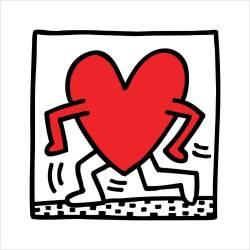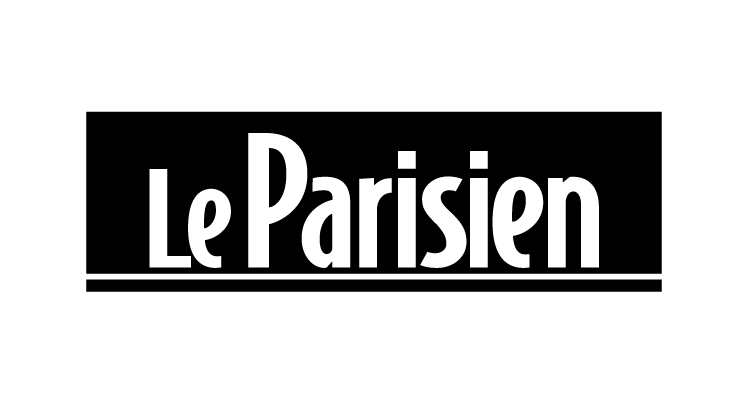Artwork of Keith Haring artprints & posters
A key figure in urban art at the end of the 20th century, Keith Haring is undeniably one of the artists who left their mark on the 80s with works whose colour still resonates today throughout the world, from the streets of the biggest cities to the greatest museums, such as the Museum of Modern Art or the Musée d'Art Moderne in Paris. Strongly committed to youth, against the ravages of drugs and HIV disease, particularly through his foundation, the Keith Haring Foundation, his imprint is all the more impactful, with each canvas, sculpture or painting having a particular significance, with characters that have entered the collective memory.
Discover the artist's works, with his ‘Radiant Baby’, one of his first iconic silhouettes, representative of the artist's work, ‘Dancing Heart’, one of his many paintings representing a heart, synonymous with his philosophy of universal love, or ‘Mickey Mouse’, a representation of the famous mouse, which is now used in numerous projects, such as with Swatch and Levi's. Treat yourself to a real piece of contemporary art history with a reproduction of Keith Haring available in the catalogue, an artist whose short life was entirely dedicated to art, and discover his biography.
Keith Haring's biography
Keith Haring's youth in Pennsylvania
Keith Haring was born in 1958 in Reading, Pennsylvania, and grew up in the town of Kutztown, in a conservative, Catholic family.
His passion for art became apparent at a very young age through his drawings, and after his studies he enrolled at the Ivy School of Professional Art in Pittsburgh at the age of 18, to study commercial art. Although this laid the foundations for his future career in the art world, the artistic style he was taught did not suit Keith Haring's desires, and he abandoned his training to devote himself fully to drawing. Discovering the underground art scene of the 80s. In Pittsburgh, the young American artist did not feel understood, which explains his early arrival in New York, a city where the artistic effervescence was at its peak in the early 80s. The energy of the underground artists of the time quickly rubbed off on Keith Haring, who became friends with rising stars of contemporary art of the time, such as Jean-Michel Basquiat, with whom he remained friends all his life, and Andy Warhol, who was already well established in pop culture with his innovative artistic style for the second half of the 20th century.
In his early days in the Big Apple, far from the colour he would use profusely later on, Haring transformed the anonymity of the subway into his personal gallery, sketching in white chalk on the empty panels of the corridors. His style did not go unnoticed, and the name Keith Haring began to resonate in New York's artistic circles, such as at Club 57, a meeting place for all the avant-garde artists of the time.
Development of the Keith Haring style, and first major works
Now well established in New York, Keith Haring wasted no time in assembling a veritable collection of works. Over the years, his painting became more pop, with a black outline that brought out the bright colours, and iconic silhouettes or reworked pop culture characters, which appeared on the walls of New York's East Village, which he used as a real canvas.
This is how, from the early 1980s, we see the appearance of his famous ‘Radiant Baby’, whose surrounding rays represent his energy, echoing that of the artist, the ‘Dancing Heart’, or his representation of Mickey, the famous Disney mouse, which he depicts in his own way. By trying his hand at numerous techniques, such as engraving, painting on many different surfaces, and even frescoes, Keith Haring wanted to use his work to convey a message, and in doing so found his own style that echoed the world around him.
The exhibition of Keith Haring's work: A promising start
With a promising start, Keith Haring's work quickly came to light, moving from the street to the exhibition halls. This is how he presented his drawings at his first solo exhibition at the Tony Shafrazi Gallery in New York in 1982. The presentation of his works at the gallery of the man who would become his regular art dealer attracted crowds, and Haring was invited to exhibit his colourful silhouettes at the Whitney Museum in 1983, which consolidated his reputation in New York and the United States.
Rapid international recognition for Keith Haring
Already considered a key figure in the New York art world, the American artist's collection of works attracted enthusiasts from all over the world, and he was invited to cross the Atlantic to exhibit in Europe, then in the rest of the world, shortly after his explosion in the United States. He thus gained rapid international recognition thanks to his daring exhibitions around the world, sometimes alongside his friend Jean-Michel Basquiat, such as in Paris, at the Musée du Luxembourg in 1984, or at the Musée d'Art Moderne de la Ville de Paris in the same year, in Kassel, Germany, or in Brazil on the occasion of the 1983 São Paulo Biennial. He even produced numerous paintings all around the globe, such as in Sydney, Melbourne, São Paulo, or in Paris, where he painted the famous fresco at the Necker Hospital in 1987.
With his reputation firmly established, Keith Haring opened his pop shop in the SoHo district in 1986, strongly supported by Andy Warhol. The concept did not appeal to the New York underground scene, but it allowed him to reach a wider audience and to collaborate with stars of the time such as Madonna.
Keith Haring: A brutal end to his career
While his career in contemporary art was in full swing, Keith Haring was diagnosed with HIV in 1988. His friend Jean-Michel Basquiat died a year later, which led to the canvas ‘A Pile of Crowns, for Jean-Michel Basquiat’, in homage to the person who had undoubtedly been the greatest inspiration in his career.
The same year, he produced his last work, ‘The Life of Christ’, an atypical sculpture in his collection, which brought the young artist back to religion as his health declined. Keith Haring died of AIDS at the beginning of 1990, aged just 31, leaving behind him a large number of paintings, sculptures and numerous frescoes that are still indelible today and can be found all over the planet. A committed artist
Iconic for his art, Keith Haring is also iconic for his commitment to strong causes during the 1980s. In particular, he used his work as a message to raise awareness about crack, the use of which was becoming increasingly frequent at that time, and AIDS, which was constantly developing.
This commitment would become even more visible in the second half of the 1980s, when he painted his ‘Crack is Wack’ mural in 1986, and in 1988, after the death of his friend Jean-Michel Basquiat from an overdose, whom he depicted in a tribute painting. He also dedicated every minute of his life to the HIV cause when he found out he had it, which led to the creation of the Keith Haring Foundation, a foundation that helps children and organisations fighting the AIDS virus.
Keith Haring's legacy in the art world
An American artist emblematic of street culture and contemporary art, Keith Haring left an immense legacy in the art world, with his works renowned for their bright colours, and his collection of characters that have entered the collective spirit of people, like his representation of Disney's Mickey Mouse, or his bright and dynamic coloured silhouettes.
From New York to Paris, via Sydney and Berlin, from exhibition to exhibition, the American artist has earned a place among the greats, but above all he has left his mark on the world's biggest cities with huge murals, such as at the Necker-Enfants malades hospital in Paris, or on a section of the Berlin Wall.
His foundation, the Keith Haring Foundation, is also a strong legacy which, even today, preserves the memory of the artist and helps children, as well as organisations involved in education, prevention and AIDS-related care. His contribution to street art is timeless and is still studied today, and his place in museums, such as the Museum of Modern Art or the Musée d'Art Moderne in Paris, is no longer in question.
Learn more about the life and the works of Keith Haring.




























